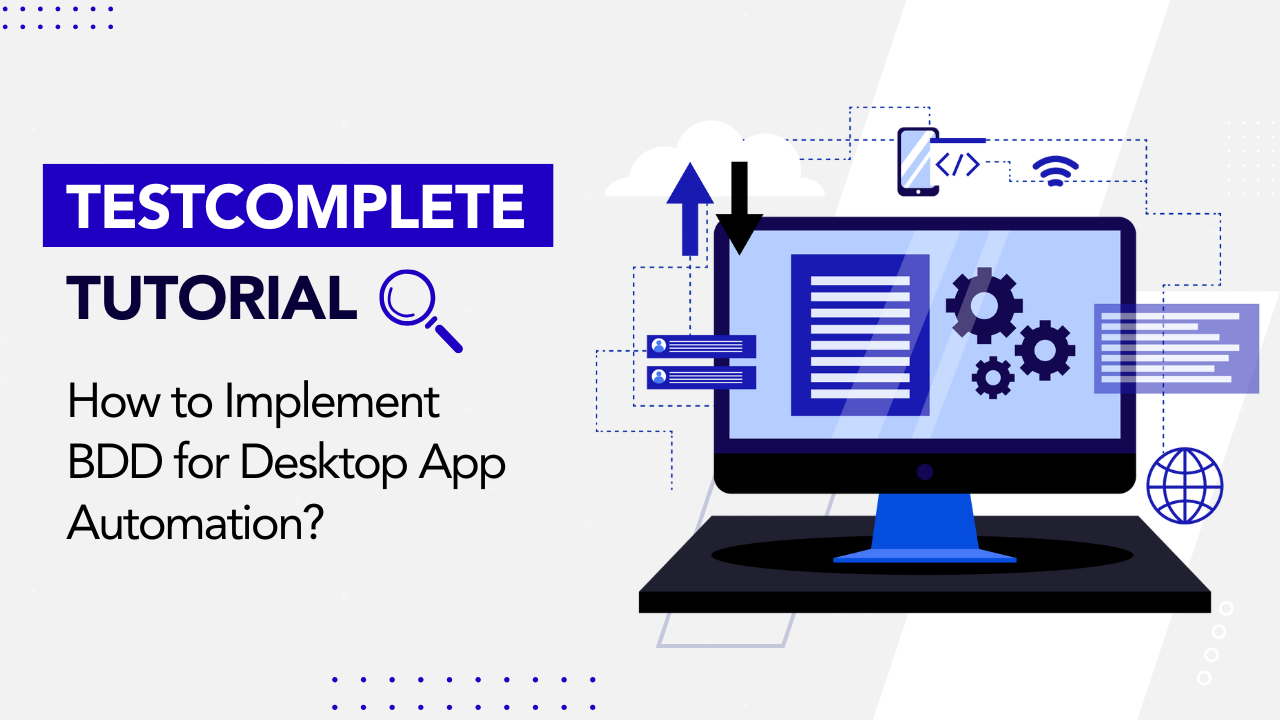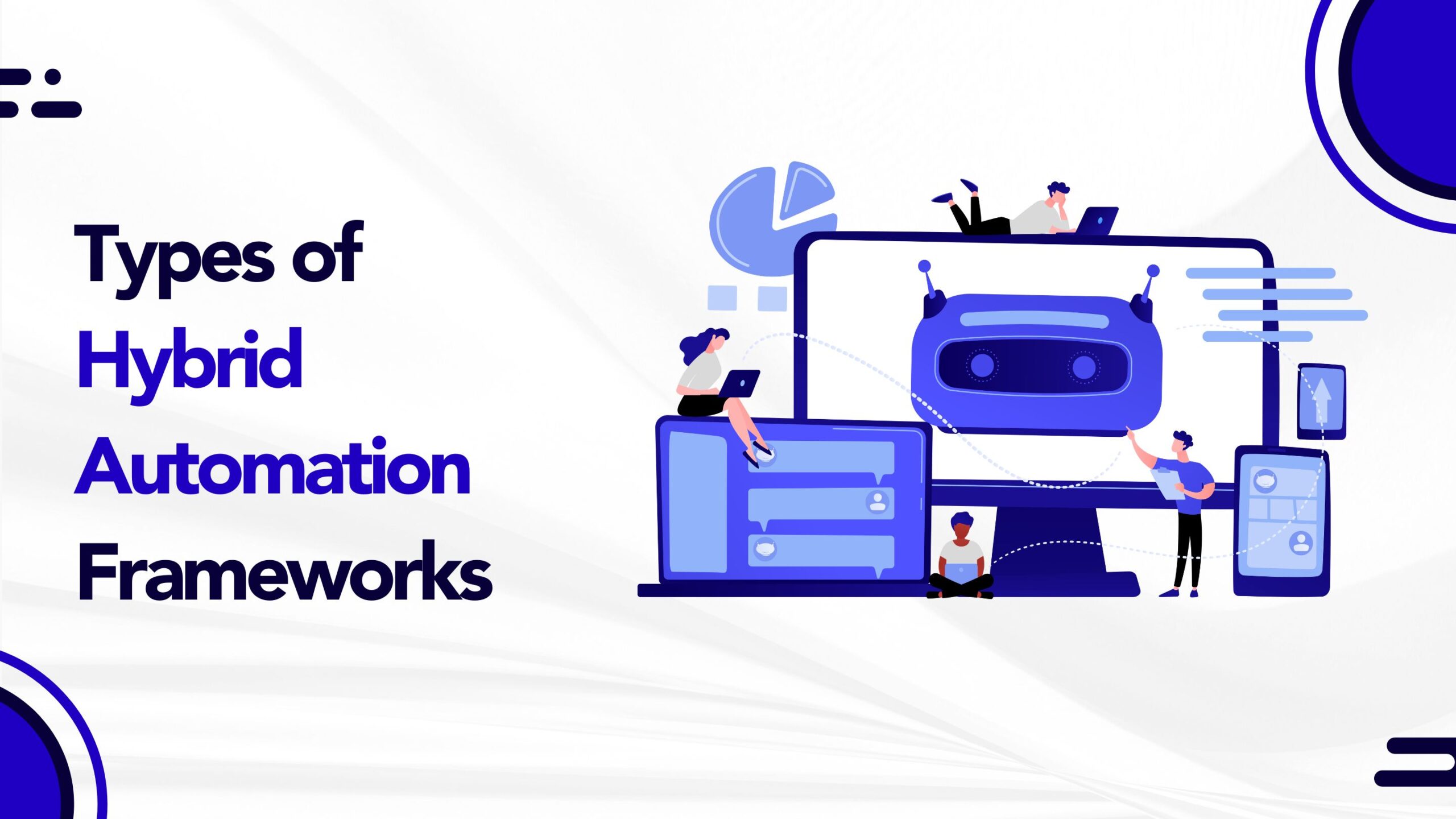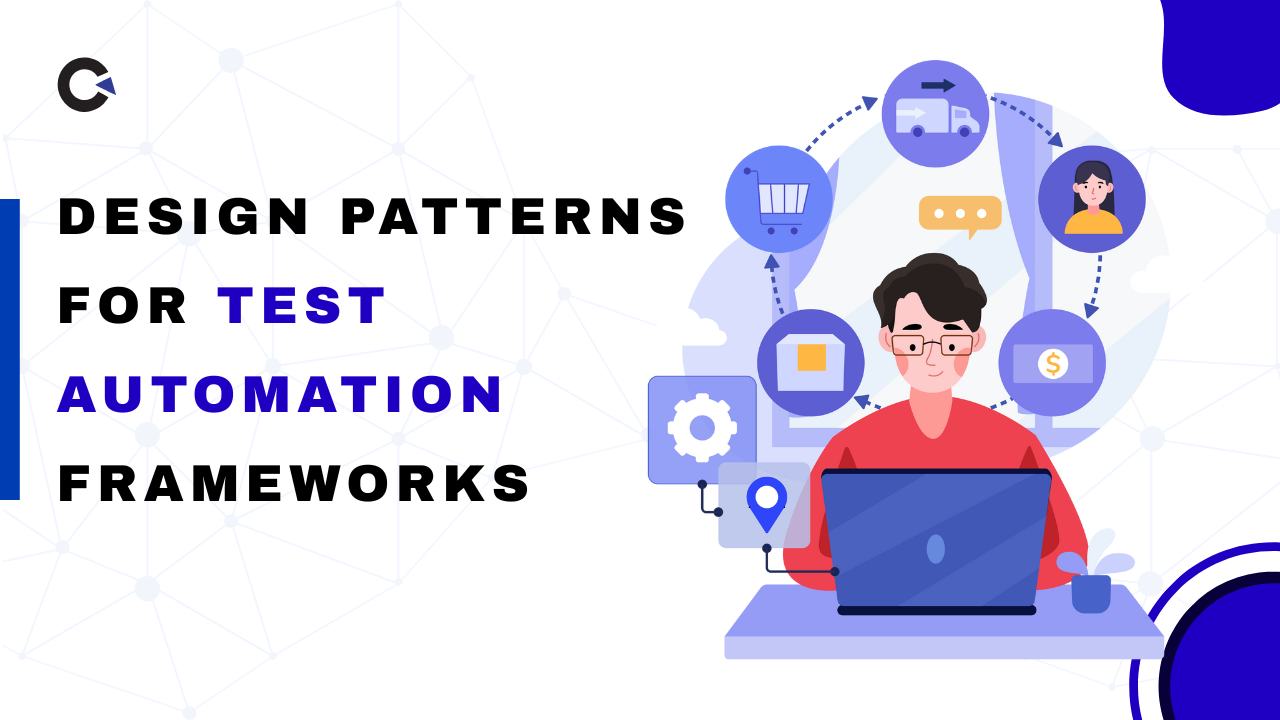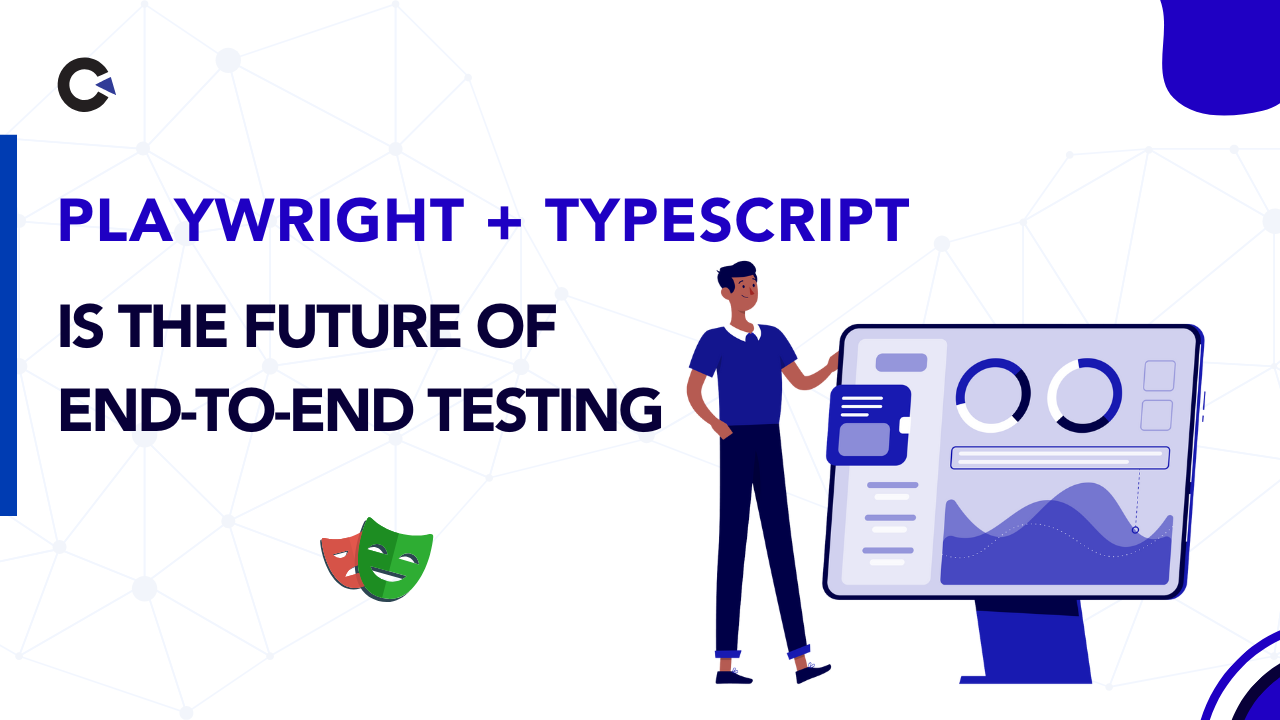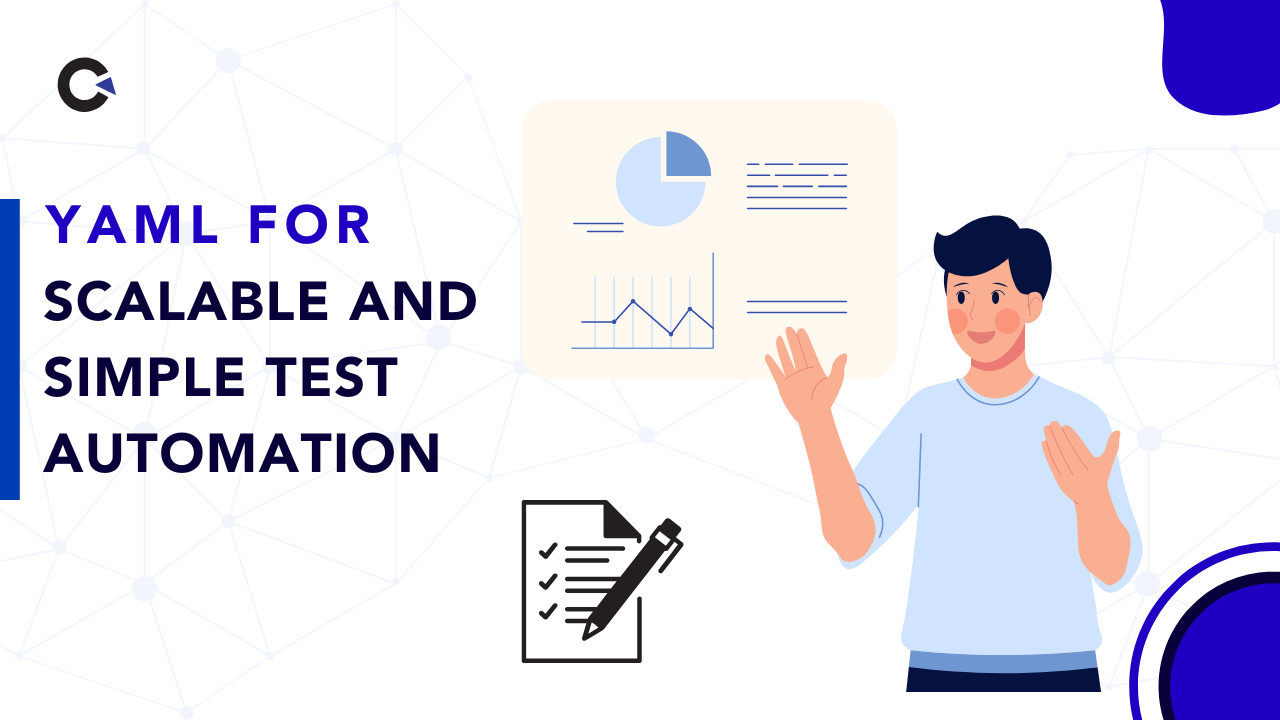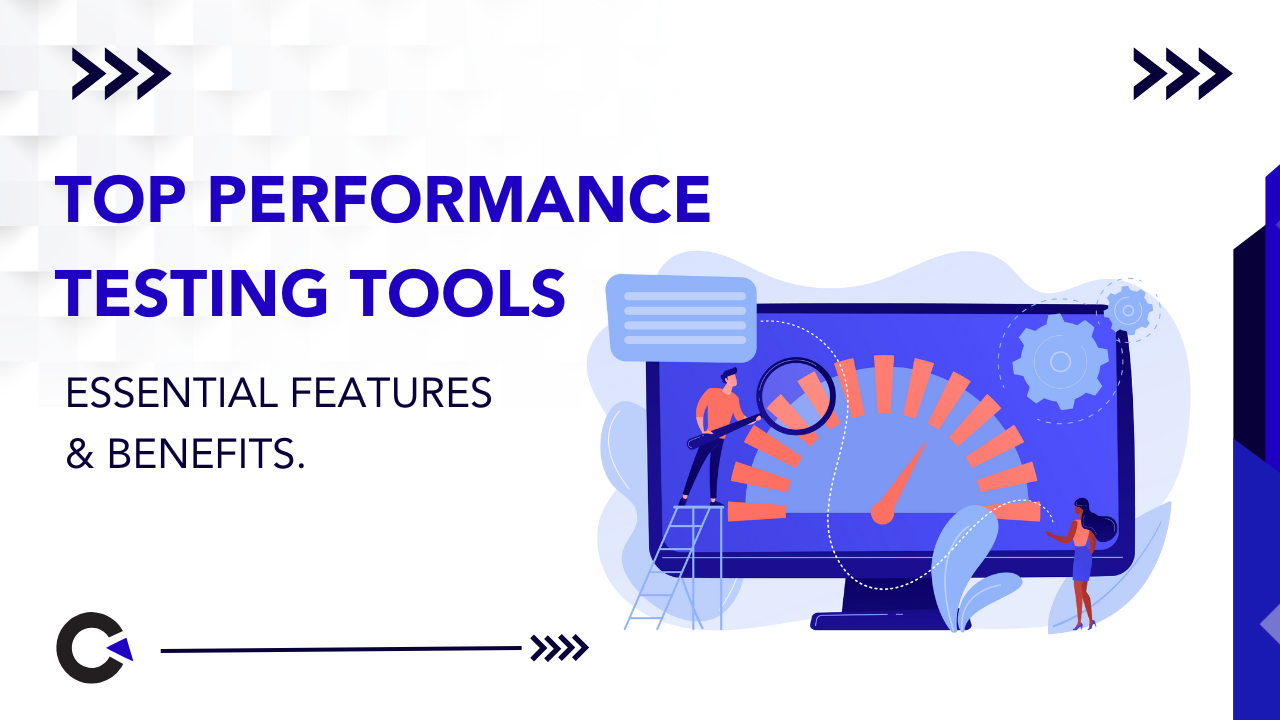
by Arthur Williams | Dec 29, 2022 | Automation Testing, Blog |
With Agile being so widely adopted across the globe in software development projects, the importance of Integration testing has also increased. Since different parts or modules of the software are developed individually in Agile, you can consider the work done only if everything works well together. A flaky test is never healthy for any type of testing, but it can be considered more critical when your integration tests are flaky.
Being an experienced automation testing company, we have encountered various factors that contribute to the flakiness of an integration test and are well-versed when it comes to fixing them. So in this blog, we will be explaining in detail how you can fix a flaky integration test.
How is Integration Testing Performed?
Integration testing is the process of making sure that two or more separate software modules are working together as defined by the requirements. In most organizations, the Unit/Component/Module integration will be performed by the developers. But automation testing companies that follow the Test-Driven-Development approach will be involved in the unit/integration testing too.
Types of Integration testing:
- The Big Bang Method
- Bottom-Up Method
- Hybrid Testing Method
- Incremental Method
- Stubs and Drivers
- Top-Down Approach
Causes of Flaky Integration Tests
1. Web Driver Test
2. Shared resources
3. Third party’s reliability
4. Sleep ()
5. UI test
WebDriver Test:
WebDriver is a web framework that allows us to execute cross-Browser tests. This tool is used to automate web applications to verify if it is working as expected. The Selenium WebDriver allows us to choose a programming language to create test cases, in that case, flakiness might cause.
Shared Resources
Shared data is one of the main reasons for integration tests to be flaky. It can be caused when tests are designed with incorrect assumptions about data and memory or due to unforeseen scenarios.
Third-Party Reliability
Integration tests could also rely more on external software or APIs in comparison to standalone tests. During such scenarios, there could be certain dependencies to which we might have limited or no access. This is yet another reason that causes a flaky integration test.
Sleep()
Since integration tests involve different components or modules of an app, sleep () time can contribute to the failure of many tests. Having too short of a wait time or a too long wait time can cause failures.
New Feature/Module
All your tests might be working fine until a new feature/module/code has been added to the existing build. Such new additions can cause flaky integration tests and so it is always important to check how stable the tests are once such new integrations are made.
UI Testing
UI Tests can turn out to be because they basically intend to run End to End testing methods and interact with the System like how real users would. Since such tests are prone to network issues or server slowness that might introduce some unexpected flakiness.
Steps to Fix Flaky Integration Tests:
Run the Test Regularly
Running your test suite at regular intervals is the first step in fixing flaky integration tests as it will help you identify them. So make sure to rerun the tests daily or at least once a week.
The more tests we rerun, the more we will be able to understand the tests. We will be able to determine helpful data such as the time it takes for the test to be executed on average. We will even know when and how the particular test is being triggered.
Once we have such data, it will be easier to identify the anomalies when they happen.
Identify the Unstable tests
Now that we have the data to identify any deviation, we will know where to look to find unstable tests. But be sure that not all failures attribute to a flaky test as there could be real scenarios impacting the result. So the first step would be to look into the error logs to see what has caused the failure.
But those tests might fail due to many reasons such as latency issues, network issues, environmental issues, coordination problems, and so on. So make sure to analyze why similar tests pass and fail randomly. If you dive deep and analyze the internal workings, you’ll be able to identify flaky test patterns.
Isolate the Flaky tests
A single flaky test can disrupt the integrity of your entire test suite. So the best course of action would be to isolate the flaky integration test from your test suite. Find out if removing the particular integration test will have any impact on your test suite on the whole and adapt accordingly.
Fix Flaky tests one at a time
In order to fix a flaky integration test, you must first identify the root cause of the problem, You can rerun the same test multiple times using the same code and try to identify the root cause of the flakiness. But this might turn out to be a tedious process if the tests end up failing continuously. So make sure to follow these steps
- Review the existing wait/ sleep time delay of the existing threads and make needful changes.
- Reorder the data source while running a test and have the process draw data from a different source. Though reordering the source station can help, it requires careful execution.
- Identify if any dependencies on external sources are causing flaky integration tests. It will be helpful if you simplify multiple threads to create a simple form as failures can be fixed when we have full access to our program instead of relying on external venues.
- Use mock testing to focus on the code more than the behaviors or the dependencies of the feature.
By posting comments to some of the code, adding print and wait-for statements as necessary, setting breakpoints, and closely watching the logs, you will be able to debug the problem’s root cause and resolve it.
Tip: A common trap that most testers fall into is wanting to find & fix all the flaky tests all at once. It will only cause them to take more time as it will be very hard to identify the root cause and come up with a permanent solution.
So focus on one flaky test at a time.
Add Stable tests back to the Test Suite
Once you are certain that the flakiness has been eliminated, you can add the isolated test back to your test suite. But you’ll have to rerun the tests over and over again to determine if the results you are getting are consistent. The reruns don’t end there as you’ll have to rerun your entire test suite after adding the fixed tests to make sure nothing else breaks.
Best Way to Handle Flaky Tests
One of the best ways to handle flaky tests is to prevent them. So when you write your automation scripts, make sure the tests are not dependent on one another. If there is too much dependency, you’ll not be able to evaluate the failures without looking into the application’s code. The objective of our tester should be able to write automation scripts in a way that you can execute them in any random order you want without any impact. But if there are such issues, you should consider splitting up those tests.
Conclusion:
Flaky integration tests or flaky tests in general are very common when it comes to automation testing. But as a leading test automation service provider, we take the necessary steps to ensure that we don’t create flaky tests in the first place. Though it is not possible to completely avoid it, the overall flakiness can be considerably lowered. So even if we do face flakiness, the above-mentioned steps have always helped fix those issues and keep our test suites healthy.

by Anika Chakraborty | Dec 20, 2022 | Automation Testing, Blog |
Designing an effective test automation framework is an integral part of automation testing. It is important that your test automation framework has no code duplication, great readability, and is easy to maintain. There are many design patterns that you can use to achieve these goals, but in our experience, we have always found Page Object Model to be the best and would recommend you follow the same. As Cypress has been gaining a lot of popularity over the years, we will be looking at how you can implement Page Object Model in Cypress. To help you understand easily, we have even used a Cypress Page Object Model example. So let’s get started.
In a Page Object Model, the page objects are always separated from the automation test scripts. Since Cypress has the ability to enable Page Object Model, the page files in POM are separated into different page objects and the test cases are written in test scripts.
How to Implement the Page Object Model in Cypress?
Being an experienced automation testing company, we have implemented Page Object Model in Cypress for various projects. Based on that experience, we have created a Cypress Page Object Model example that will make it easy for you to understand.
Let’s assume that we have to automate the login process in a sample page and that we have two pages (Home Page & Login Page) to focus on.
Create a Pages Folder
The project structure is an aspect we’ll need to know for implementing Page Object Model in Cypress. So we have created a separate folder called pages under the Cypress folder to store both the Home and Login pages.
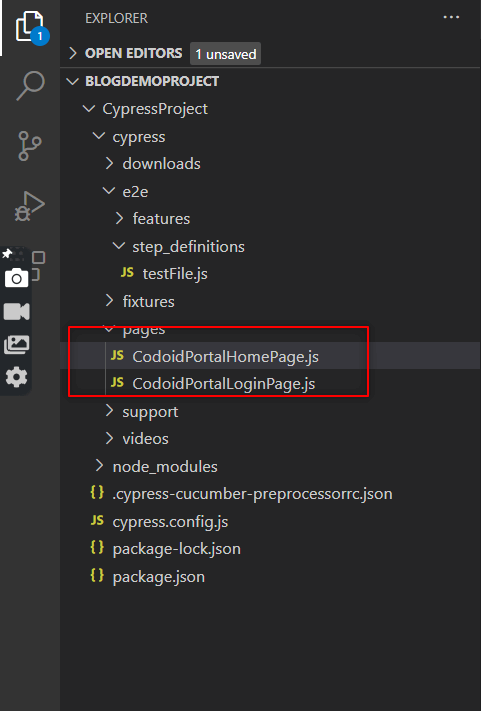
In the example above, we can see both the CodoidPortalHomePage.js and CodoidPortalLoginPage.js. Under the ‘pages’ folder we created.
Add Methods & Locators
Now that we have created separate pages, we have added all the required methods related to Codoid’s home page to CodoidPortalhomePage.js and the ones related to Codoid’s login page to CodoidPortalLoginPage.js.
To increase the reusability, we have added the locators as variables in both instances.
Home Page
export class CodoidPortalHomePage{
txtBox_Search = ':nth-child(2) > .oxd-input-group > :nth-child(2) > .oxd-input'
codoidLogo = ':nth-child(3) > .oxd-input-group > :nth-child(2) > .oxd-input'
btnSearchIcon = '.oxd-button'
enterSearchKeyword(Username){
cy.get(this.txtBox_Search).type(Username)
}
verifyCodoidLogo(Password){
cy.contains(this.codoidLogo)
}
clickSearchIcon(){
cy.get(this.btnSearchIcon).click()
}
}
Login Page
export class CodoidPortalLoginPage{
txtBox_UserName = ':nth-child(2) > .oxd-input-group > :nth-child(2) > .oxd-input'
txtBox_Passwords = ':nth-child(3) > .oxd-input-group > :nth-child(2) > .oxd-input'
btnLogin = '.oxd-button'
txtDashBoardInHomePage = '.oxd-topbar-header-breadcrumb > .oxd-text'
txtInvalidcredentials = 'Invalid credentials'
subTabAdmin = 'Admin'
txtSystemUserInAdminTab = 'System Users'
enterUserName(Username){
cy.get(this.txtBox_UserName).type(Username)
}
enterPassword(Password){
cy.get(this.txtBox_Passwords).type(Password)
}
clickLoginBtn(){
cy.get(this.btnLogin).click()
}
verifyHomePage(){
cy.get(this.txtDashBoardInHomePage)
}
verifyAdminSection(){
cy.contains(this.subTabAdmin).click()
}
verifySystemUser(){
cy.contains(this.txtSystemUserInAdminTab)
}
}
Create a Step Definition Folder
The next step in implementing Page Object Model in Cypress would be to create a ‘Step Definition folder. We have created it under the ‘e2e’ folder, which stores all the test cases. We have then created a test spec file by the name ‘testFile.js’ under the ‘step definitions’ folder.
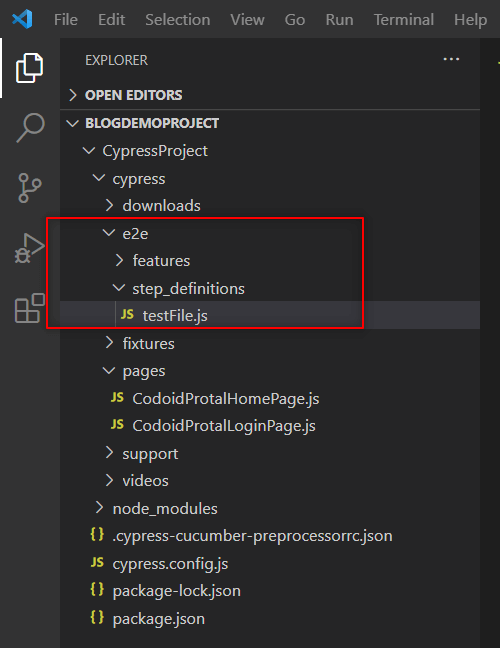
Note: If you are using a Cypress version that is below 10, you’ll have to create a ‘step definitions’ folder under ‘integration’ and not under e2e.
Import & Execute
The final step in implementing the Page Object Model in Cypress would be to import the pages we have created to access its methods and execute them. So we will be creating instances of the CodoidPortalHomePage.js and CodoidPortalLoginPage.js classes and call the respective methods as shown in the code snippet below.
import {
Given,
When,
Then,
} from "@badeball/cypress-cucumber-preprocessor";
import { HomePage } from "../../pages/CodoidPortalHomePage";
import { LoginPage } from "../../pages/CodoidPortalLoginPage";
const homeage = new CodoidPortalHomePage()
const loginPage = new CodoidPortalLoginPage()
Given('User is at the login page', () => {
cy.visit('https://opensource-demo.orangehrmlive.com/')
})
When('User enters username as {string} and password as {string}', (username, password) => {
loginPage.enterUserName('Admin')
loginPage.enterPassword('admin123')
})
When('User clicks on login button', () => {
loginPage.clickLoginBtn()
})
Then('User is able to successfully login to the Website', () => {
homeage.verifyHomePage()
})
Now that we have implemented Page object model in Cypress, it’s time to execute the test file in Cypress. So you can open Cypress by running the following command in the terminal.
Once you have opened Cypress, all you have to do is run the testfile.spec.js file.
Best Practices for Page Object Model in Cypress
Assertions should not be included in page objects
When building end-to-end test scripts, aim to include only one main assertion or a set of assertions per script. Additionally, you should not place assertions in any of the functions provided by your page objects.
Identify the page object class by using a clear name
It’s important to make sure the name you choose makes it 100% clear what’s inside the page object. If there is a scenario where you are unable to pinpoint what the page object does, then it is a sign that the page object does too much. So make sure to keep your page objects focused on particular functions.
Methods in the page class should interact with the HTML pages or components
Make sure your page class has only the methods that an end user can use to interact with the web application.
Use Locators as variables
There are high chances for the “Xpath” of an element changes in the future. So if you use a locator as a variable, you can just change the Xpath of the single file, and it will be applied to all the other files that call the same “Xpath”.
Separate the Verification Steps
Ensure to separate the UI operations and flow from the verification steps to make your code clean and easy to understand.
Conclusion:
So in addition to using a Cypress Page Object Model example, we have also listed the best practices that you can use to implement the same in your project. Implementing Page Object Model in Cypress will make it very easy when you have to scale your project and make maintaining it seamless as well. Being a leading automation testing service provider, we will be publishing such insightful blogs regularly. So make sure you subscribe to our newsletter to never miss out.

by Hannah Rivera | Dec 13, 2022 | Automation Testing, Blog |
JetBrains (formerly IntelliJ Software ) is a Czech software development company that specializes in tools for programmers and project managers. Jetbrains has developed many popular Integrated Development Environments (IDEs) such as Intellij IDEA, Pycharm, WebStorm and so on. Their IDEs support various programming languages such as Java, Groovy, Kotlin, Ruby, Python, PHP, C, Objective-C, C++, C#, F#, Go, JavaScript, and SQL. And Aqua is their newest addition to their existing lineup. It is a powerful IDE developed by keeping Test Automation in focus. It is a treat for QA and test engineering professionals in modern software development. Being a leading automation testing company, we are always on the lookout for new tools and technologies that can help us enhance our testing process. So in this blog, we will be focusing on Jetbrains Aqua and its features that make it a great IDE for testers.
There are a lot of features in Aqua that a test automation engineer needs on a daily basis, which includes
- A Multi-language IDE (with support for JVM, Python, JavaScript, and so on)
- A new, powerful web inspector for UI automation
- Built-in HTTP client for API Testing
- Database management functionality
Intelligent Coding Assistance
As with other JetBrains IDEs, Aqua checks your code on-the-fly for quality and validity. If issues are found, the IDE suggests context actions to help you resolve them. As of writing this blog, Aqua provides intelligent coding assistance for Java, Kotlin, Python, JavaScript, TypeScript, and SQL. To use the context action, click the light bulb icon (or press Alt+Enter).
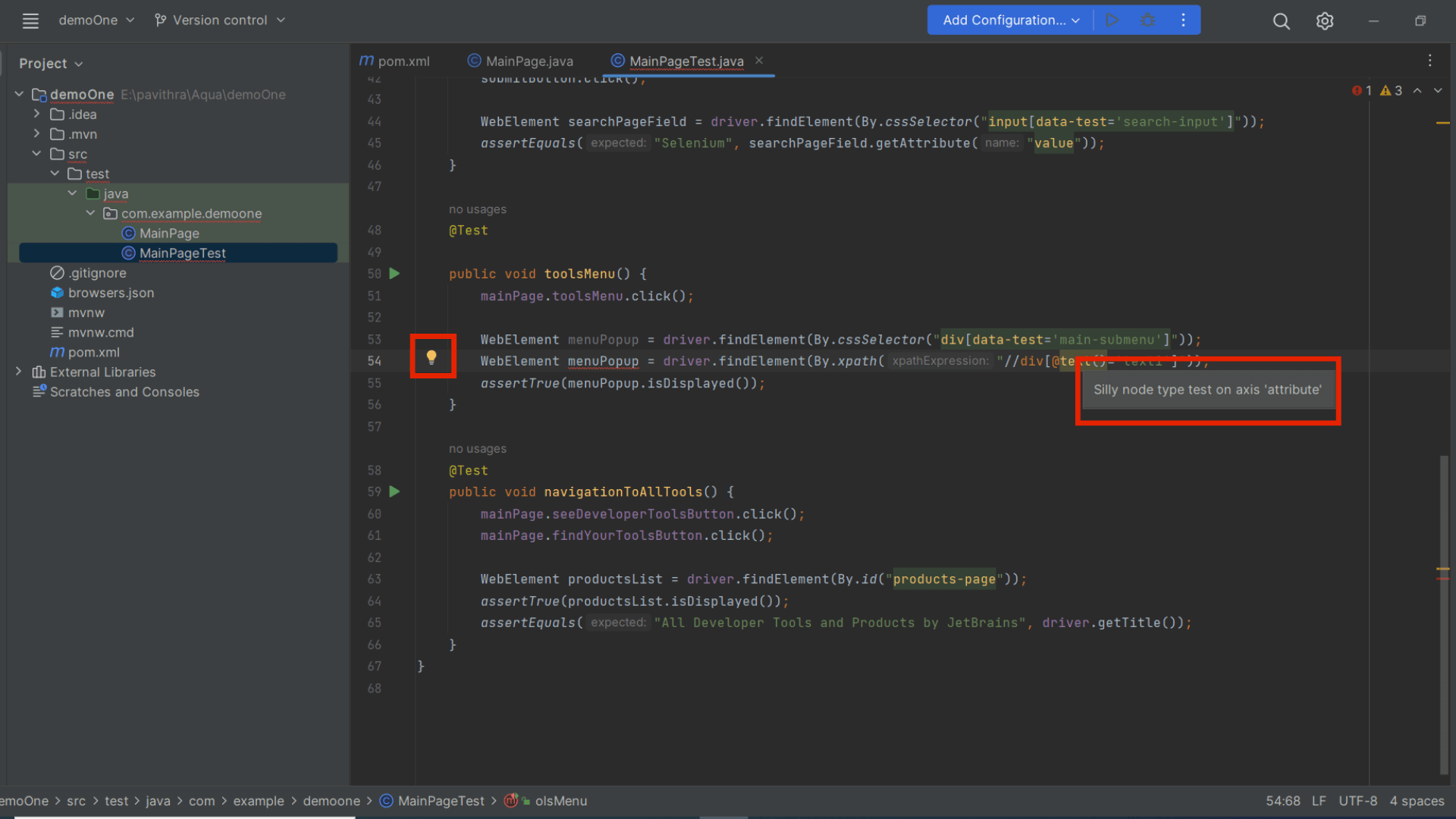
In addition to that, clicking Shift twice allows you to search across classes, files, Action, and Database.
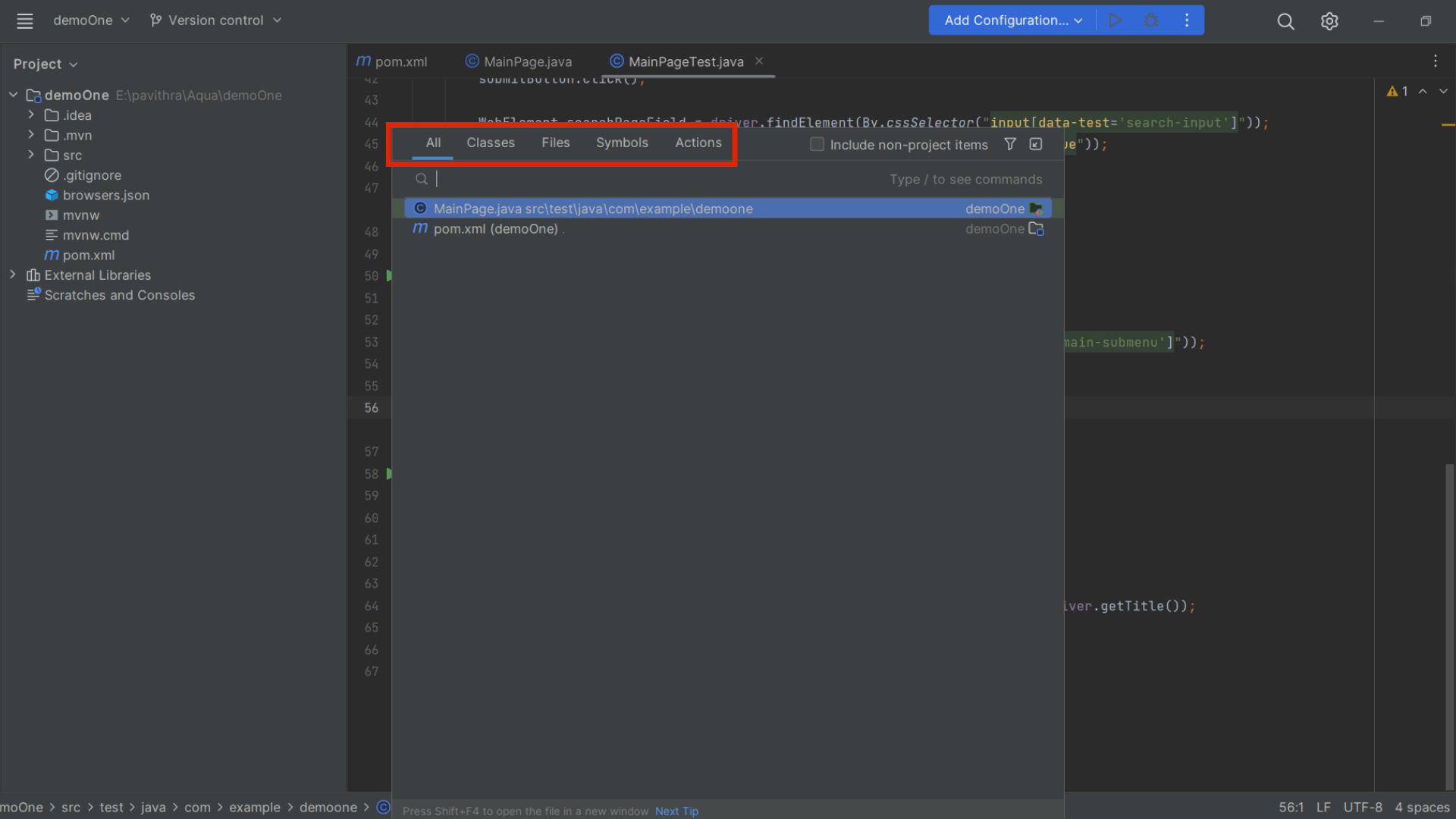
Starting a New Project
Creating a new project is so cool in Jetbrains Aqua as you can choose the build tool (Maven or Gradle), Test runner (JUnit or TestNG), JDK, and language for the project. To make it even easier for you, JetBrains Aqua even provides you with a sample script when you are creating a project for the first time.
Aqua supports JUnit, TestNG, Pytest, Jest, Mocha, and other popular frameworks for writing, running, and debugging unit tests. Code insights are also provided by Jetbrains Aqua for CSS, XPath, and many other libraries used in UI testing.
You can choose the page object pattern you want to use in the IDE and Jetbrains Aqua will use the corresponding pattern when adding the locators. Though the URL field is optional, it will be useful when identifying the locators.
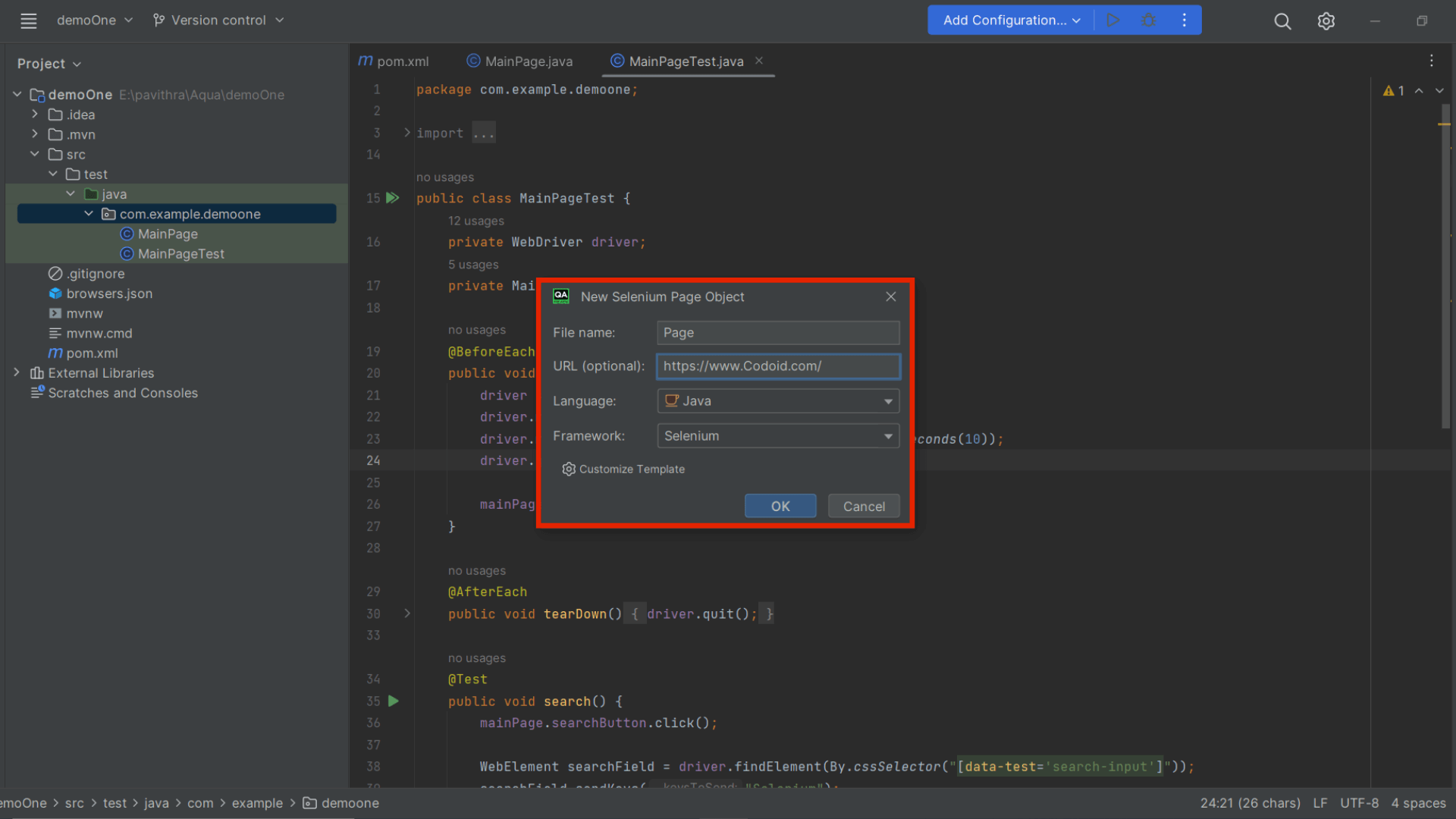
Web Inspector
Now that there is an inbuilt Web Inspector in Jetbrain Aqua, you can explore the web application you want to perform automation for and collect the required page elements. Aqua provides CSS or XPath locators for the chosen elements on the webpage and aids in adding it to the source code.
The best part is that it will assign a valid name to the web elements you chose instead of assigning a random name. It is known by all that an element might have more than one unique Xpath or CSS for a web element. So the Web Inspector will fetch all the available variations as shown in the below screenshot.
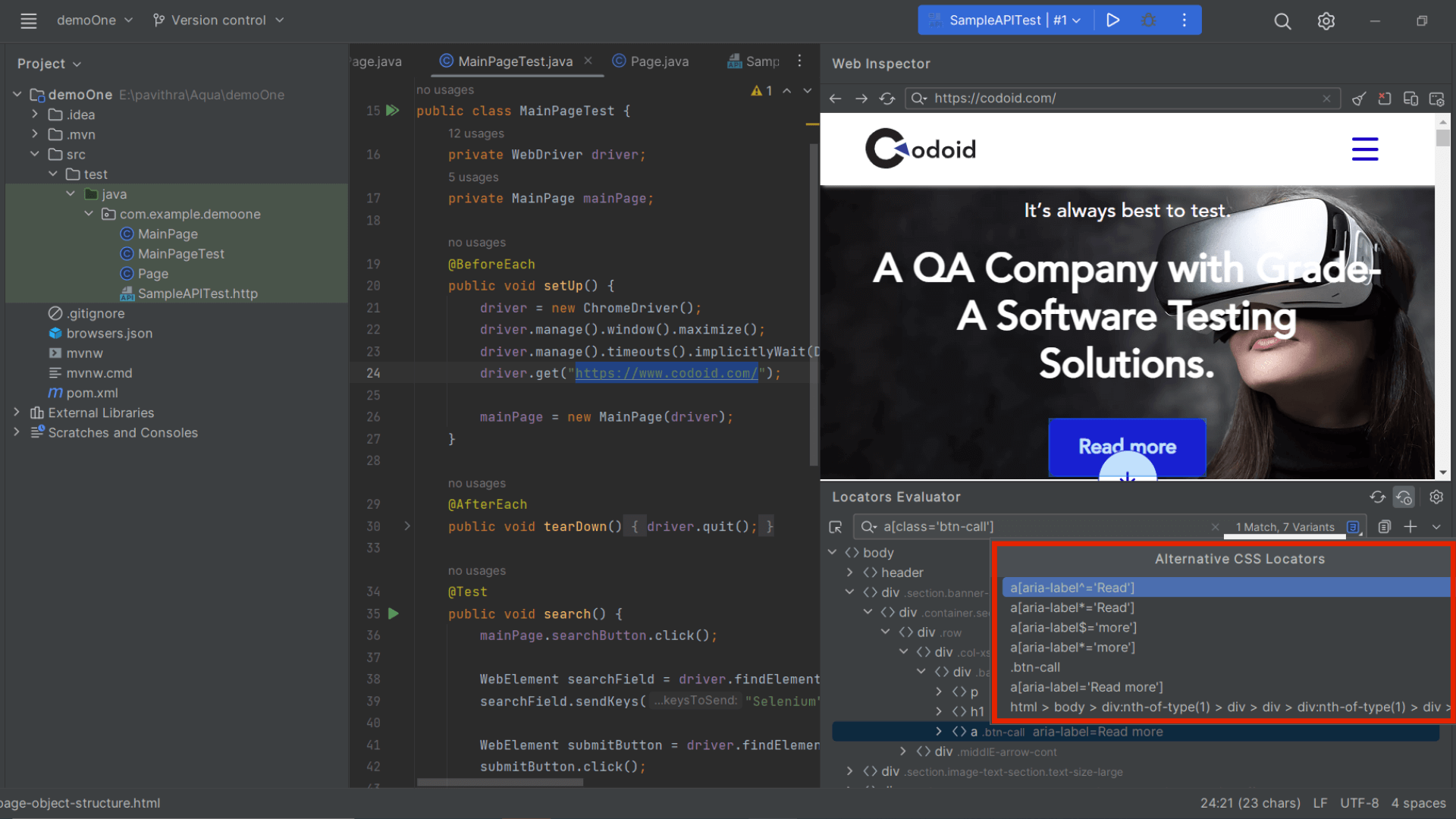
If you are working with multiple sites, the web inspector has a history feature that will come in handy. You can use it to select the site you want from the drop-down in the search bar as shown below.

HTTP Client
Every web service will send and receive numerous HTTP requests. As Jetbrain Aqua has an inbuilt HTTP client, you will be able to create and edit the requests. So you will be able to perform API tests where you can use commands such as get, post, put, etc in the IDE to check the response body and response code.
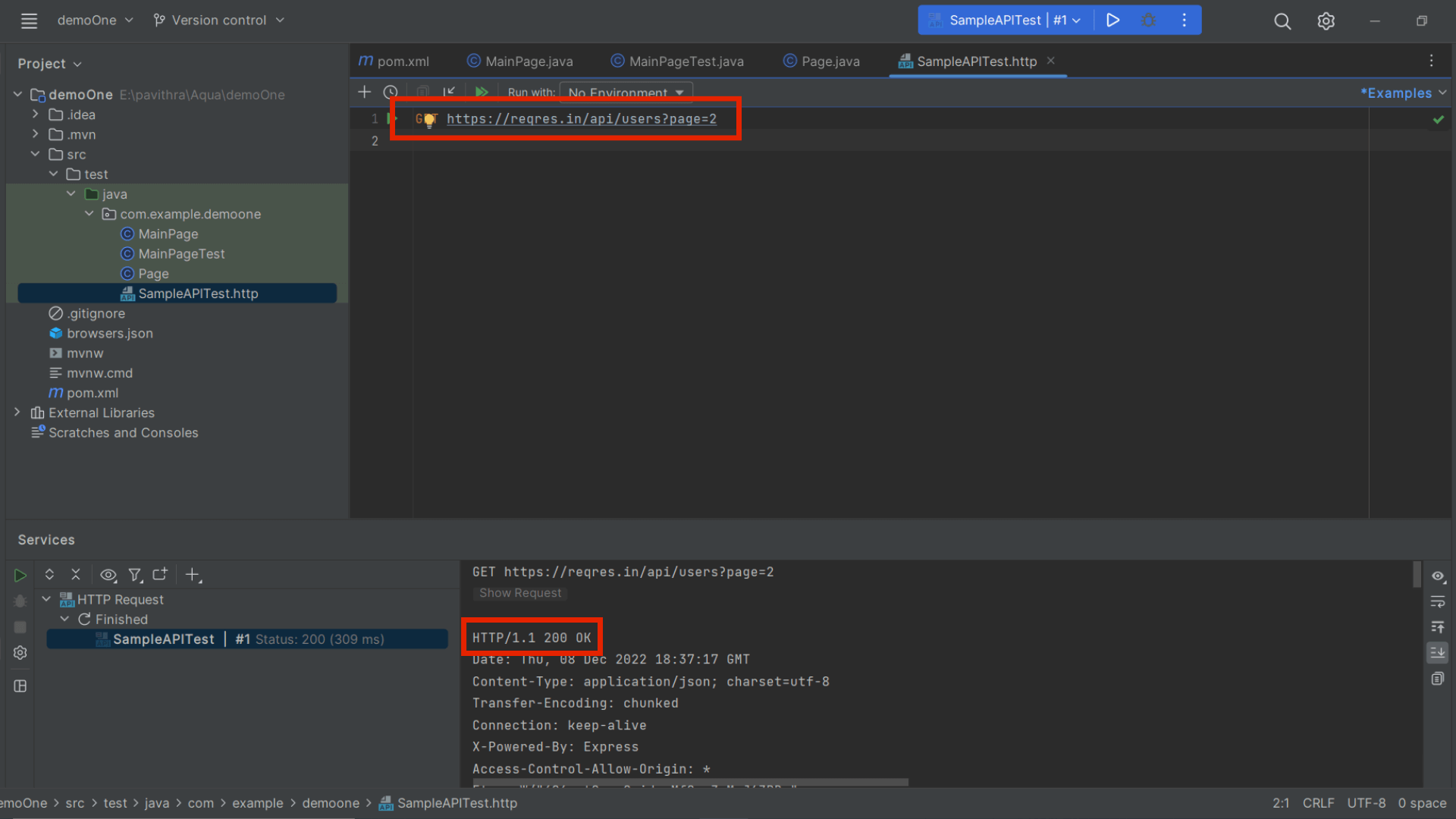
In the above image, we have used the GET command and got 200 as the response code.
Database Management
If you have been performing automated data analytics testing, you’ll definitely love this new feature in Jetbrain Aqua. Using Aqua, you’ll be able to handle multiple databases, develop SQL scripts, and perform data assertions to a certain extent right from the IDE. So you’ll be able to connect to live databases, run & validate the required queries, export the data, and manage the schemes with the help of a visual interface. Some of the well-known databases that you can access are Oracle, SQL Server, PostgreSQL, MySQL, and so on.
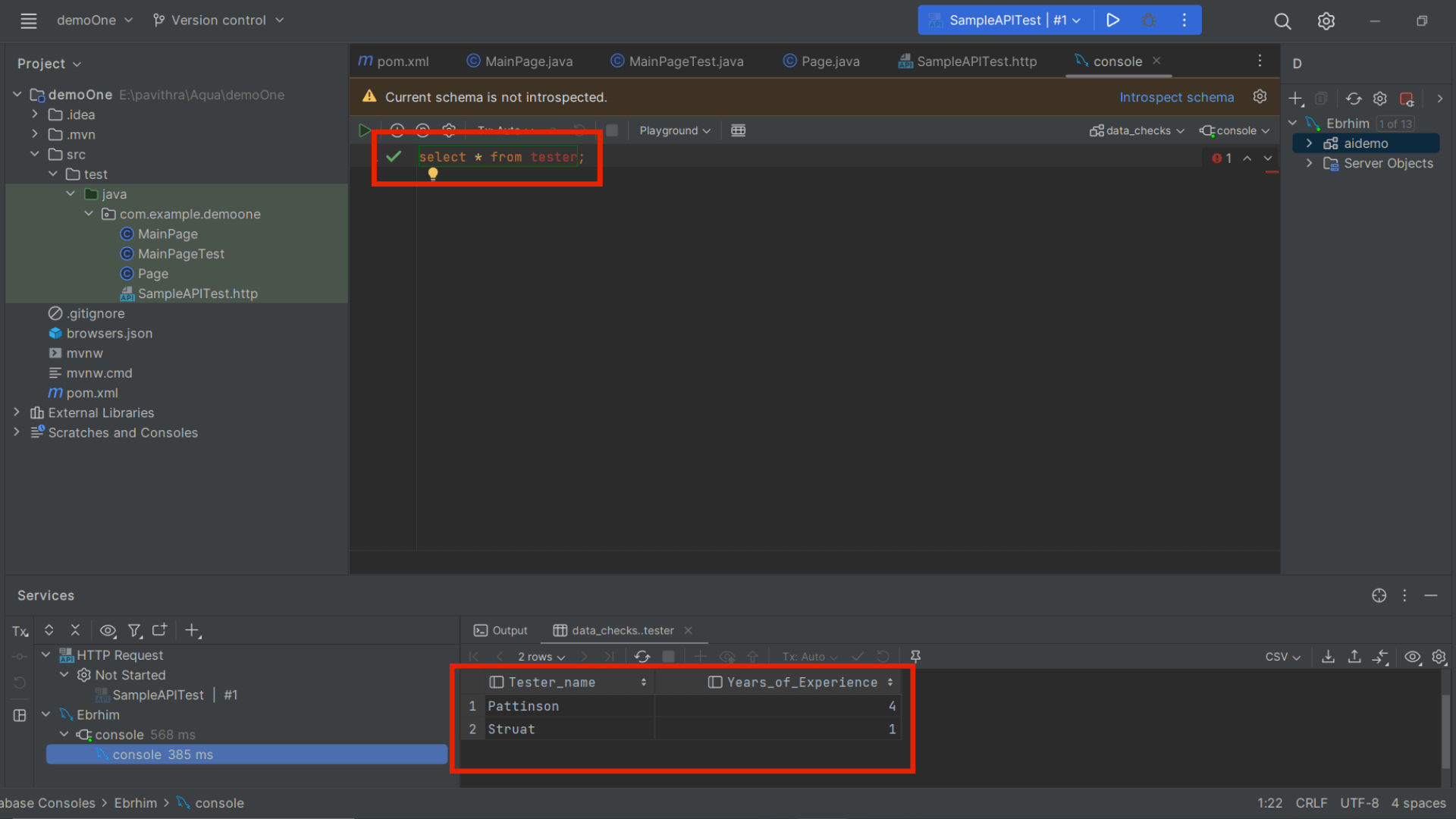
If you take a look at the above image, we have connected to an SQL server and used the Select command to extract the required details.
Conclusion
Even if you have existing projects in Maven, Eclipse, and Gradle, you can import those projects to Jetbrains Aqua and make use of all these new features. As one of the leading automation testing companies in the industry, we are excited to use Jetbrains Aqua in our projects. Hopefully, we have explained the features of Jetbrains Aqua in a way that has encouraged you to use it as well. Subscribe to our newsletter to stay updated with all the latest test automation tools, methods, and so on.

by Arthur Williams | Dec 6, 2022 | Automation Testing, Blog |
Selenium is a popular open-source test automation tool that has been in the software industry for nearly 2 decades. It has been the go-to tool for testers when it comes to web automation. Even we have been using Selenium to deliver exceptional automation testing services to our clients all these years. But we are always focused on using the best tools, and so when Cypress started to gain a lot of popularity in recent years, we keenly looked into it and now have a clear understanding of both these tools. So in this blog, we will be pitting Cypress vs Selenium to help you choose the right tool for your needs with our analysis.
Selenium:
By now almost everyone in software testing would be aware of Selenium. But if in case you are new, you might need an introduction. Selenium is an open-source automation testing framework for web applications that was initially released in 2004. Selenium 4 is the most recent and stable version of Selenium.
Cypress:
Despite being used for the same purpose as Selenium, Cypress does differ architecturally from Selenium. It uses a DOM manipulation technique to directly interact with the web browsers without needing specific browser drivers in Selenium. Since it uses JavaScript for its automation test scripts, it is popular with developers.
Cypress vs Selenium: Points that Matter
No single tool can cater to the wide range of needs of different people. That is why it is important to opt for the tool that is the most suitable for your particular needs. In addition to that, choosing the right automation framework plays an integral part in your automation testing’s success. So before we head to the Cypress vs Selenium comparison table, let’s first learn what are the main aspects to look into when choosing between Cypress and Selenium or any other automation tool for that matter.
Testing
The first and foremost factor is the type of automation tests you are looking to execute or in need of for your project. When it comes to Cypress vs Selenium, they do support a wide range of tests. Cypress in specific supports API testing, whereas Selenium doesn’t support it. Cypress is also great for unit testing as developers are more comfortable with it when compared to Selenium. Both options are equally good when it comes to performing end-to-end testing.
Language support
Apart from the testing capabilities of the tool, another pivotal aspect to consider is the programming languages it supports. Though it is preferable to pick one that supports multiple languages, make sure the language you want to use is supported. You should consider the programming language used in the project in general and also your available talent pool when making this decision. When it comes to Cypress vs Selenium, Selenium supports more number of languages in comparison.
Cross-Browser Testing
Being web-based automation testing tools, testing across different browsers would be a crucial part. As of writing this blog, Cypress doesn’t support automating tests on Safari and Internet Explorer. Though IE has been discontinued, you might be in a position to test a legacy application that depends on IE. So Selenium would be the way to go if cross-browser testing is a priority.
Apart from execution speed, the number of tests that can be in parallel is also a crucial factor when comparing Cypress vs Selenium. Selenium with the help of Selenium Grid is the clear winner here as it eases cross-browser testing across platforms. Whereas Cypress doesn’t provide the option of running more than one browser at a time.
In-Built Features
- User-friendly features such as the automatic scrolling option that ensures an object or element is in the viewport before actions such as clicks are executed.
- There is also no need for the tester to use explicit/implicit wait commands like in Selenium.
- There are also options to control the behavior of server responses, timers, and functions using stubs, clocks, and spies.
- The Test Runner in Cypress makes it possible for testers to go through every step before and after screenshots making it easy to debug.
- Cypress is also packed with reliable and ready-to-use frameworks. Whereas you’ll have to build everything from scratch when it comes to Selenium.
- Flaky tests are also reduced thanks to the retry capability of actions performed over elements.
Ease of Use
So when pitting Cypress vs Selenium, the previous points we saw were the major dealbreakers. If you have what you are looking for in both these options, then you can consider how easy or usable the tool is for your usage. As discussed earlier, developers would lean towards Cypress as it is great for Unit testing. It also has a relatively easier installation & setup process.
Selenium has been around for a long time and so it naturally has an edge when it comes to community support with code samples, and so on. But Cypress also has a rapidly growing community and really effective documentation.
Cypress vs Selenium: Key Highlights
| Features |
Cypress |
Selenium |
| Testing |
Supports End-to-End and API Testing |
Supports End-to-End testing, but not API Testing. |
| Supported Languages |
JavaScript and Typescript. |
Java, JavaScript, Perl, PHP, Python, Ruby, C#, and other languages are supported. |
| Users |
It is developer-friendly since developers were considered throughout its development. It is also used by Testers. |
Predominantly used by Testers. |
| Browsers compatibility |
Firefox and all chromium-based browsers (Chrome, Edge, Brave). |
Chrome, Opera, Firefox, Edge, Internet Explorer, Safari, and other major browsers. |
| Performance |
It is quicker since it has a distinct architecture that does not use |
Its architecture makes it difficult to write simple, quick tests. The platform, on the other hand, is fast, and you can run many tests at scale, in parallel, and across browsers. |
| Usability |
It will be simple if you are familiar with JavaScript. Otherwise, it can be a little difficult. |
As it supports multiple languages, people can quickly start writing tests. It also has well-defined syntaxes and good maintainability. |
| Installation setup |
Run the following command: npm install -save-dev Cypress |
The installation process is more complicated and time-consuming. |
| Plugins |
Though it has fewer integrations, it does support a large number of plugins. |
It integrates well with CI/CD, visual testing, cloud, and reporting tools. |
| Reference Documentation |
It is a growing community and provides good samples and documentation. |
It has a wide online community and excellent code and samples. |
| Parallel Testing |
Yes (Limited) |
Yes |
| Mobile Testing |
No |
Yes (But only with Appium) |
Why Choose Selenium?
- If you or your team aren’t familiar with JavaScript, then Selenium is the choice for you.
- Cross-browser testing is a strong suit of Selenium, and if that is a priority; opt for Selenium.
- Automation scripts can be run in parallel or simultaneously by Selenium.
- Selenium is useful in DevOps and continuous integration because it can be easily integrated with Jenkins, Maven, and other tools.
- Selenium makes it possible to perform headless browser testing.
- Selenium has a record and play [IDE] that simplifies the automation testing process. There is even an option to export this recording script in your preferred language.
Why Choose Cypress?
- Cypress can test all modern applications including Angular, React Vue JavaScript.
- If you need to perform API testing, Cypress is the only choice.
- Cypress would be better for developers as it is great for performing Unit testing.
- People who are strong in JavaScript would love Cypress as it has great debugging capabilities.
- Cypress is generally considered to be more reliable and fast as it works on real browsers, unlike other tools which simulate the browsers.
- Cypress’s in-built reporting is better than Selenium. But you can overcome this issue by integrating Selenium with TestNG or Cucumber.
Conclusion:
We hope our Cypress vs Selenium blog has laid out all the important points you’ll need to consider when choosing between these tools. As we saw in our blog, both these tools are great in their own ways. So make sure to pick the tool that fits your needs. Being an experienced automation testing service provider, we choose the tool for our project on the same basis. Make sure to subscribe to our newsletter as we will be publishing more insightful content on a regular basis.

by Arthur Williams | Oct 18, 2022 | Automation Testing, Blog |
Test automation is a very crucial part of software testing as it enables the testers to automate repetitive tasks and use the saved-up time to unearth hard-to-find bugs with exploratory testing and other methods. This is what we as a leading automation testing company do to enhance overall quality. But achieving truly reliable automated testing that requires no supervision is no easy task and might even seem impossible to many. That is where tools such as Rapise come into the picture as they simplify the process of automating your tests. So in this Rapise Automation Tool Tutorial, we will be sharing with you how you can use the tool to test your web and desktop applications.
An Introduction to Rapise
Rapise is one of the many products available from Inflectra that is used for record and play automation testing. Rapise uses its very own Rapise Visual Language to create a spreadsheet-based editor that allows users to easily see what actions have been recorded for automation. But the biggest benefit of using the Rapise Visual Language is that it makes editing the tests extremely easy. Of the various record and play automation testing tools we have used, we found Rapise to be very capable. So let’s find out how you can use this tool in our Rapise Automation tool tutorial.
Rapise Automation Tool Tutorial
If you have not yet downloaded the Rapise Automation Testing tool, you can download it by visiting the Inflectra website and download the tool by creating an account. Once you have downloaded and installed Rapise, your first step would be to click on File -> Create New Test button to open the required dialog box.
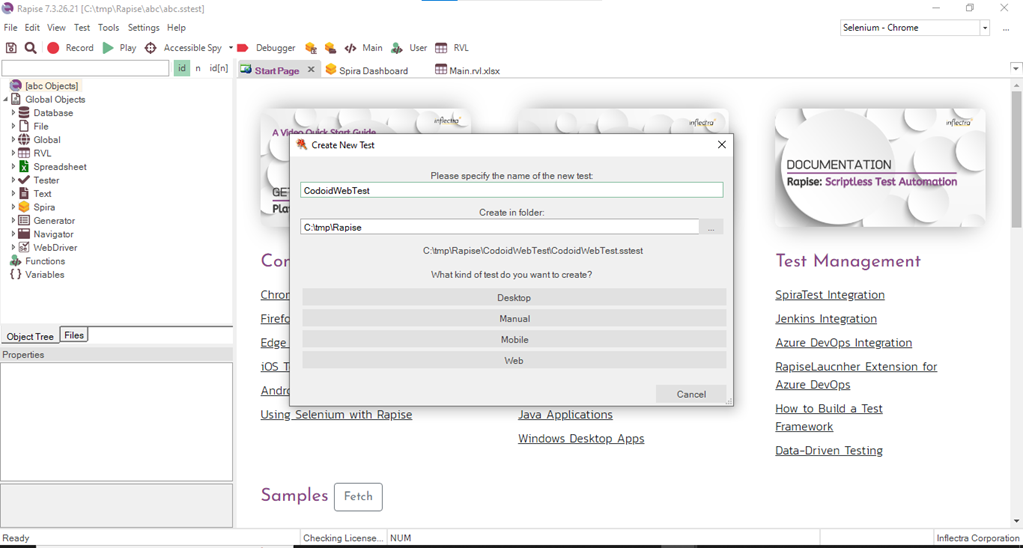
You will now be able to name your test and define the type of application you need to test in the Create New Test pop-up window. As mentioned earlier, Rapise can be used to test Desktop, Web, and Mobile apps. So this one step will be common for all apps, and from this point onwards, the steps will vary based on your choice. But in order to get a general understanding of how everything works, let’s see how to automate web testing and use that as a base to understand how to automate other apps as well.
Web Automation Testing with Rapise
Once you have opted for Web-based Automation, you’ll have to specify the web profile that you wish to test with. In this Rapise Automation Tool Tutorial, we have used the Selenium Chrome combination. But there are other browser options available such as Firefox, Internet Explorer and Edge. If you’re looking to test on different browsers such as Safari or Opera, Rapise does provide a set of Selenium WebDriver libraries that you can use.
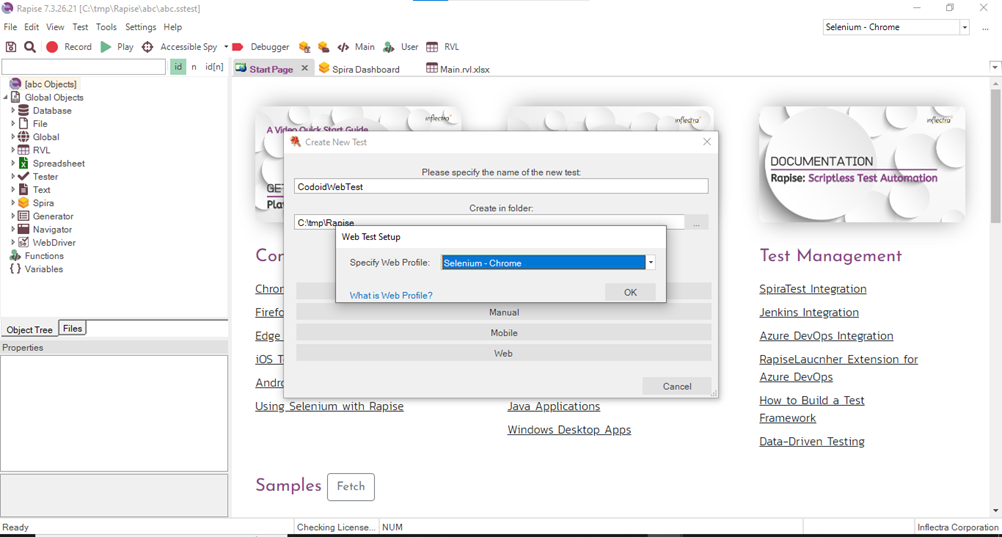
Once you have chosen the type of application you want to automate, you will be asked to choose between two scripting languages RVL (Rapise Visual Language) and JavaScript. RVL is the most convenient way to automate your tests and gets most of the job done as well. So we have chosen RVL for this Rapise Automation Tool Tutorial. But if you are in need of any advanced features for specific requirements, you can opt for JavaScript and utilize that.
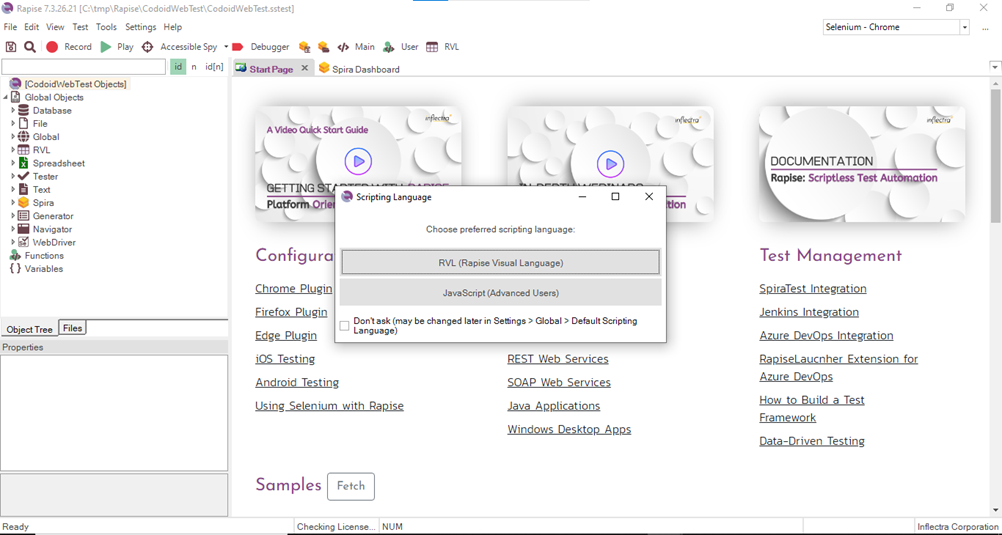
Once you have chosen the language of your choice, the main window that you can you use to automate your tests will appear.

Since there is a record and play feature, all you have to do is
- Hit the Record button.
- Provide the URL of the website you want to test.
- Perform the actions you want to be automated.
- Hit the Play button for the same actions to be executed in a new browser window.
Recording the Test
Let’s walk you through these simple steps with the help of an example in our Rapise Automation Tool Tutorial. Let’s say we want to open our website and want to navigate to the About Us page and the Our Products page. So we will click on the Record button and enter our Home Page URL.

The specified URL will be loaded in a Chrome browser window. It will also be accompanied by the Recording Activity window that you can use to Pause, Finish, or even Cancel the recording. Once you have performed all the actions you wanted to record, you can go ahead and press the Finish button to stop the recording.
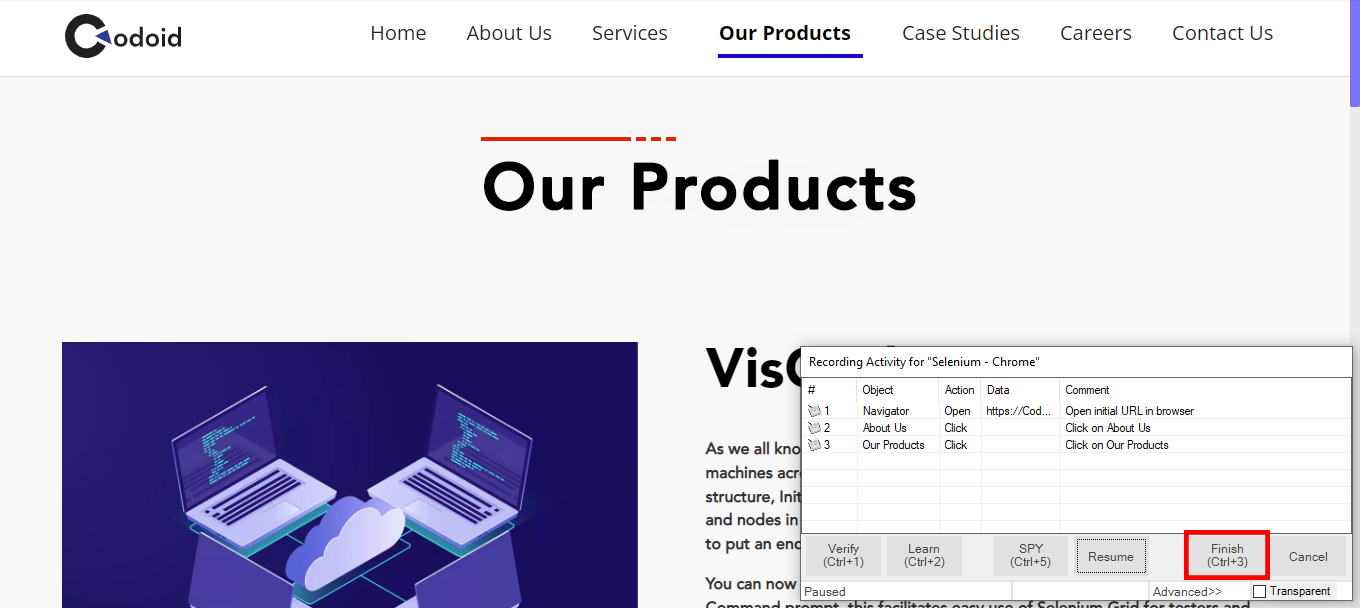
Executing the Tests
Now the performed actions will be updated in the main window in the Rapise language as shown below. The Type column will always be mentioned as action and in the two adjacent columns, we can see what action is being performed on what object.
Since clicks do not require any parameters, the other 3 columns are empty. But when we look at the action of opening the home page, the parameter information such as the name, type, and value is stored. Next up in our Rapise Automation Tool Tutorial, we’ll be looking at the other available features before we execute our test.
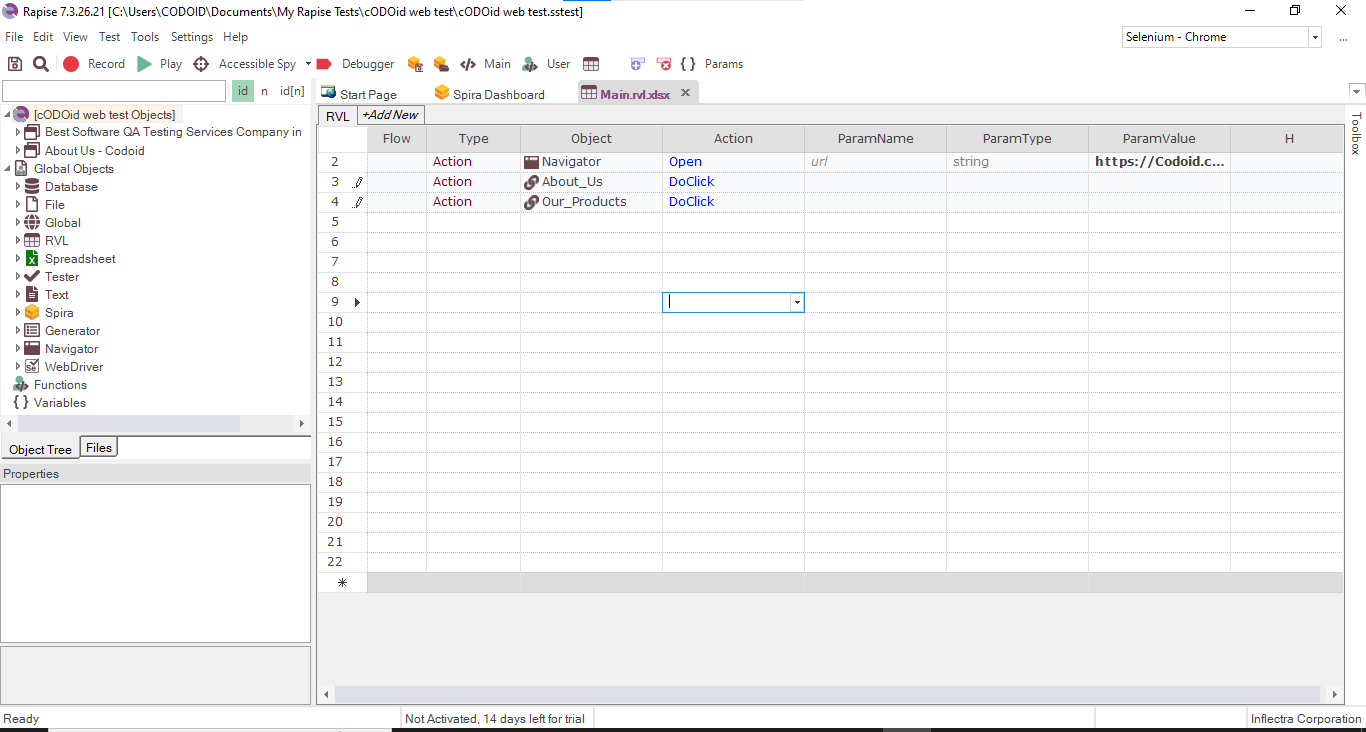
You can use the Debugger option to see a preview of how the test will be automated before you execute it. If you feel like you have to make any changes to the recording, you can do so easily. Let’s say you don’t want to navigate to the Our Products tab as mentioned, you can just select the row and delete it instead of rerecording the entire video.
Now that everything is ready the way you want it to be, you can just click the Play button to execute the test. Once the execution is done, the results will be loaded in the main window and you can view if all the tests have passed or failed.
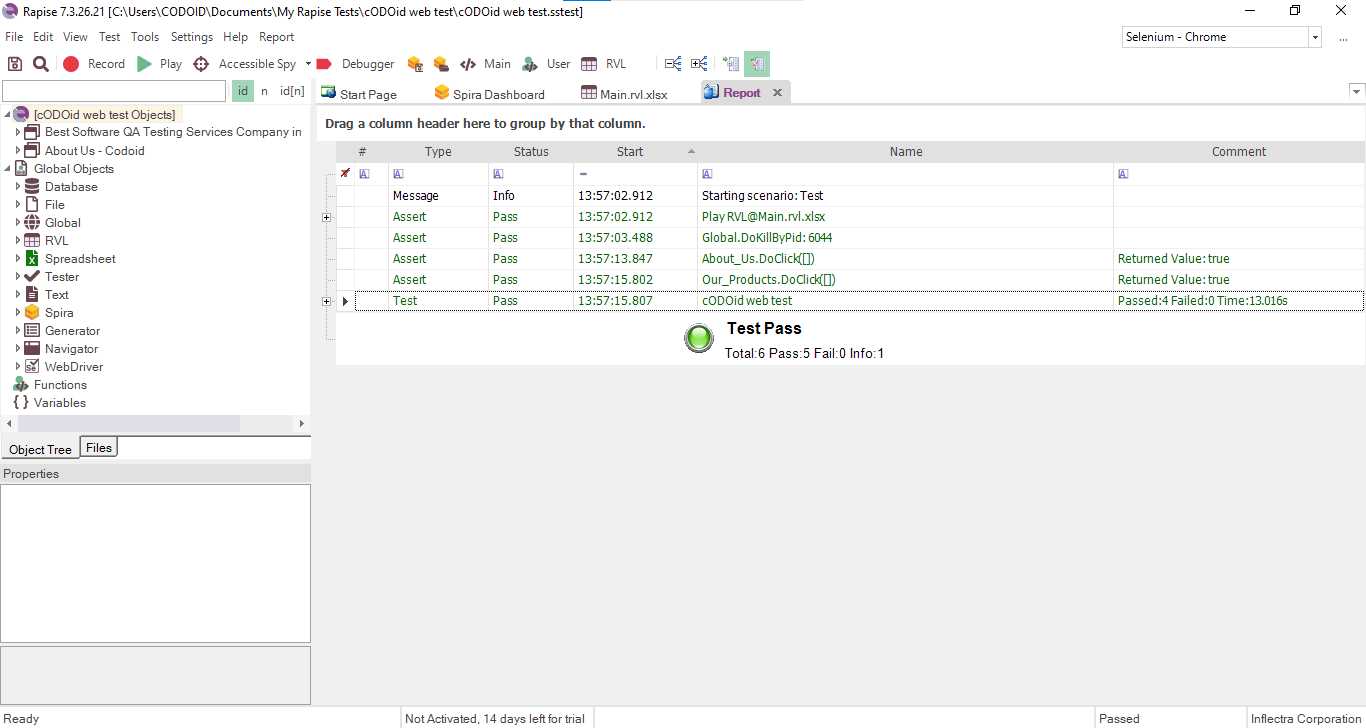
Advantages:
1. Recording your tests in one browser is enough for cross-browser testing as Rapise will be able to use the same recording for the other browsers as well.
2. Easy to edit your existing recording without having to rerecord them.
Desktop App Automation with Rapise
There is not much of a difference between automating a web app or a desktop app except for a small variation. In order to not make our Rapise Automation Tool Tutorial redundant, we will be seeing only a quick walkthrough and mention the changes from Web App automation. The only major change is that you will not have to choose the browser that you want to test with and that step will be skipped. Instead, you’ll have to choose the desktop application you want to automate after clicking the Record button once the Main window appears.
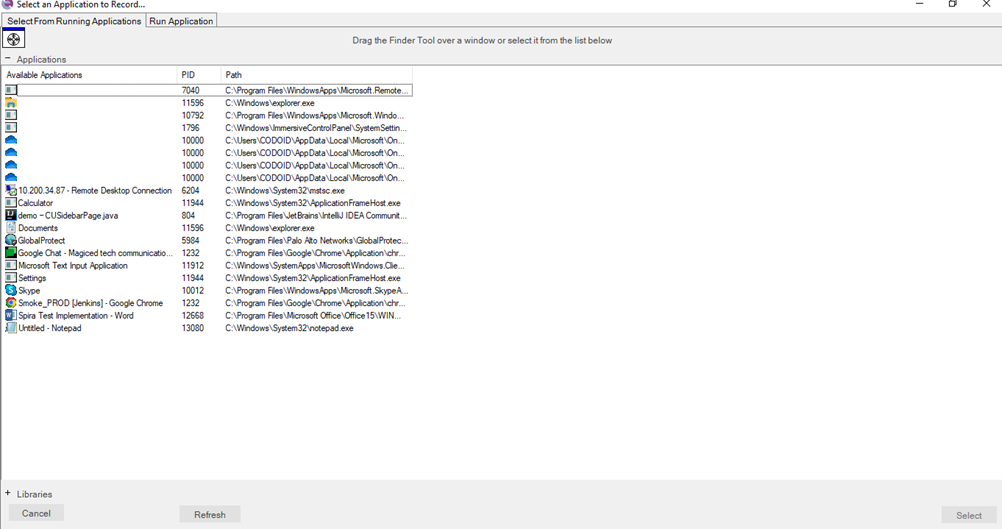
The steps will be the same as what we saw for automated web testing. We have chosen Notepad as an example in this Rapise Automation Tool Tutorial. Once notepad opened, we maximized the screen and typed a sample text (Codoid Desktop Automation Rapise) for which we got the following data in your Main window.
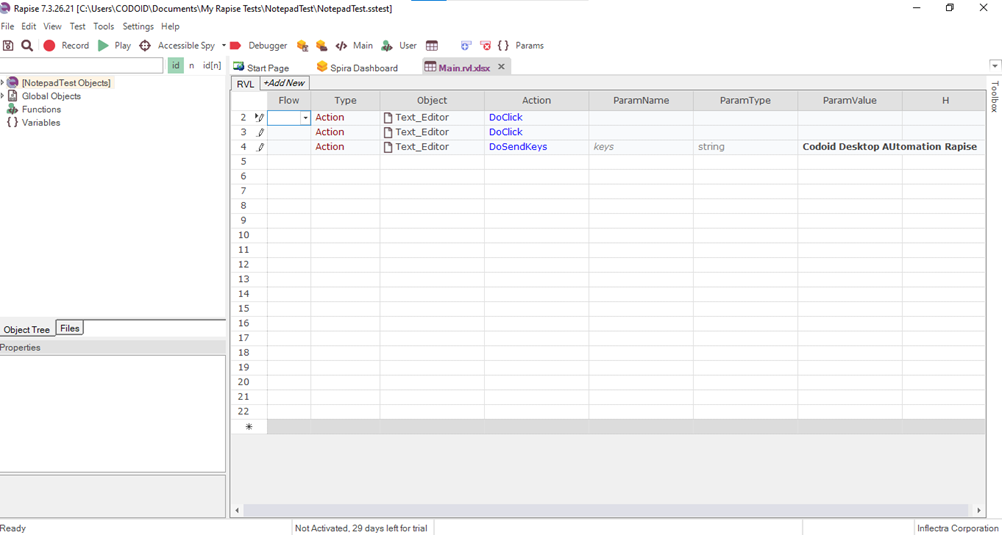
You can perform the same actions we saw before such as debugging, executing the test cases, and finally viewing the report in the dashboard.
Conclusion
By now it would be evident that Rapise is truly an effective tool when it comes to automating your tests with the least effort. And we hope this Rapise Automation tool tutorial has helped you understand how to use the tool effectively. Being a pioneer in the software testing field, we will be updating such informative content on a regular basis. So make sure to subscribe to our newsletter to keep up with our latest content.

by Charlotte Johnson | Apr 20, 2022 | Automation Testing |
Agile is a methodology that allows for continuous development and testing iterations across the software development life cycle. Iteration is defined as a minor software release. Agile Enterprise begins with a rapid mix of development and testing at the start of the project. The term “Agile” may be defined as “moving quickly and readily.”
In Agile Testing, testers are constantly working with the development team, and testing is done in parallel and after a piece of code has been written. Daily team meetings and discussions are an essential aspect of agile initiatives. It is beneficial to identify problems early on and work on them in a systematic manner.
How Things Were Done Before Agile
Before Agile, teams employed the Waterfall model. There were several stages that a project had to go through to be completed. The phases and processes were quite time-consuming. When a project begins, the development team will go through many stages and generate a large amount of documentation. Finally, the team would test the project and discover that it had several flaws. The project and its needs were not well defined, and there was a great deal of misunderstanding across the teams.
Finally, the project would be handed to the client, who would then provide feedback on the project. Many initiatives would fail due to the difficulties that were found along the line.
What Did Agile Bring to the Table?
Agile provided a method of developing software by relying on tangible measures and focusing on delivering products that are of value to the end-user. The purpose of agile is to provide continuous, incremental delivery of high-quality deliverables. The small deliverables are tested and improved by the Agile Team.
This ensures that the project does not lose momentum when the client sees that there are some issues. The agile process allows for the development of a high-quality project, and the team can discover the issues early on and fix them quickly and effectively.
How Automated Testing Made Agile Even Better
Test automation has become an essential component of current software testing approaches such as DevOps and Agile. Testing specialists and enterprises have come together to create a complete Enterprise Test Automation plan that will aid in the development of quicker and better apps.
Test Automation necessitates risk unique to training resources and tools, so making the most of the consideration is critical. It is also vital to quantify the real benefits that should result from choosing automation of tests versus manual testing. It is vital to specify the parameters before the process begins so that achieving the success rate is easy. Some significant areas of focus are as follows:
- Enhanced test coverage may be achieved by adding every part of the application for testing in the test suite.
- The amount of effort and time needed to execute the test cases may be reduced.
- Automation will eliminate the possibility of human error in selecting the correct test scripts that are to be executed.
- The automated test cases can be integrated with the Continuous Integration (CI) and Continuous Delivery (CD) processes.
- Test Automation tools and test frameworks are continuously updated and improved, making their existence even more important.
Bottom Line
Test Automation is now an essential part of every DevOps and Agile project. It ensures excellent quality of the product and quick improvement of the product. It creates a balance between development and testing. A well-defined test automation plan will accelerate your speed to market and ensure a quality product.
Are you looking for the top software testing companies in the USA? Codoid offers world-class testing services to ensure that your application is ready. Get in touch with us to learn more!




